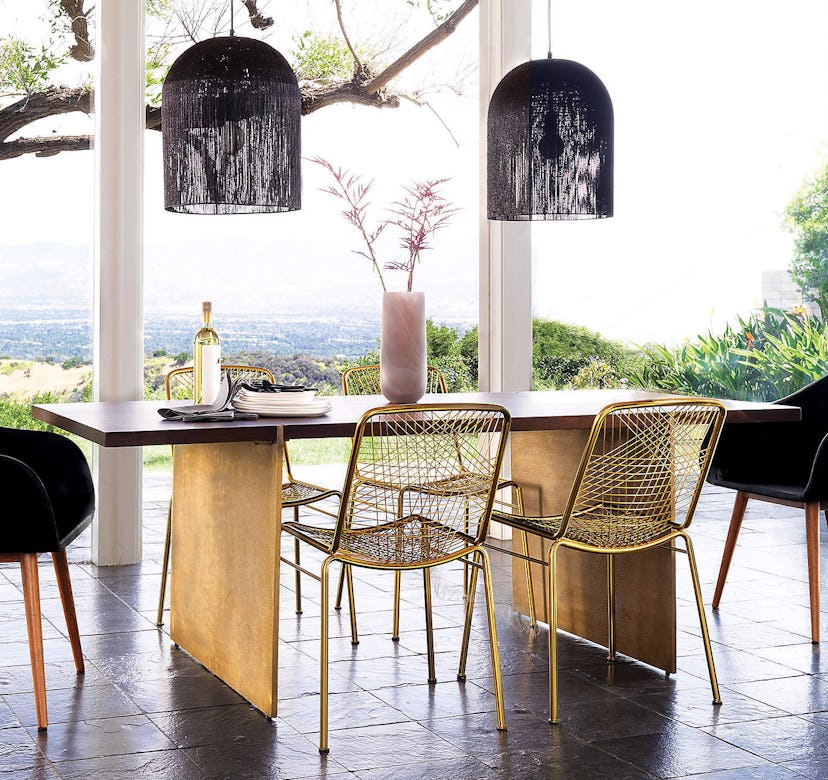(Home)
The One Rule You Should Always Follow When Decorating With Brass Decor
According to designers.

To state the obvious, brass is not new, and neither is its use in interior design. So while there’s an undeniable uptick in its use in the home at the moment, to call it a trend isn’t exactly correct. Rather, brass decor is having more of a resurgence — meaning now’s as good a time as ever to learn how to decorate with it in your space.
It’s true: Experts are seeing the material make a comeback, and in myriad ways. “Although brass was once considered dated and passé, it’s now making its way into all aspects of design as warmer metallic tones take precedence over cool steel, silver, and chrome,” says Michelle Boudreau of Michelle Boudreau Design. And Kellie Sirna, founder and principal of Studio 11 Design, shares similar insights. “In both residential and hospitality design, I’ve noticed an increase in brass accents,” she tells TZR.
Designers have theories for why this is, of course. According to Sirna, “Brass adds a hint of glam, warms up a space, and complements the natural, earthy tones that people are craving these days.” Plus, as Daniella Villamil of Daniella Villamil Interiors notes, “The beauty of brass is that it can be used with any style; it will look good in a French Provincial interior as well as in a contemporary home.”
Likely due to these benefits (and many others), Amy Pigliacampo of Amy Pigliacampo Interiors says that “brass is everywhere at every price point the last few years!” This will definitely make shopping for the metal easier, sure. However, you may still require some guidance when it comes to incorporating it into your home. If that’s the case, keep reading — all the advice you need from interior designers on nailing brass decor in your space is ahead.
Treat It Like Jewelry
A lot of people tend to think that mixing metals in the home is off limits, but according to Sirna, there really are no rules. “For instance, in a kitchen it feels natural to mix stainless appliances with brass cabinet hardware; yet in a bathroom I tend to stick to one or the other,” she says. Obviously, it will depend on the space you’re creating. However, as a general rule of thumb, she likes to think of the metal in a room as the jewelry. (And every other designer TZR spoke to agreed with that sentiment.) “Just like you mix gold and silver when putting together an outfit, it’s [equally] normal to mix metals when designing a space,” she elaborates. Villamil agrees. “I love mixing metals in the rooms we design,” she says. “It creates the visual tension needed for an interior to remain interesting and feel current.”
If you’re still feeling a little lost on combining different metals, though, look to the advice of Elisa Baran of Elisa Baran, LLC, which gets a little more specific. According to her, mixing aged metals is a win: “For example, a gunmetal finish would pair lovely with an aged brass one,” she says. That said, she wouldn’t pair polished on polished together. And, she continues, “Even mixing a polished chrome with an aged brass is a bit of an eyesore.” As for tones? According to Villamil, you should think about opposites. “I like to mix cool and warm metals for contrast in a room,” she says.
Practice Restraint
As with most things in life, too much brass is never a good thing. Yes, it can be a glamorous and warm accent in a space. But the key word there is accent — once it becomes a focus, it can quickly go overboard. Boudreau explains this simply: “I feel that anything heavily repeated in the same material or finish is quite unappealing and uninviting,” she says. The same, of course, is true with brass. “[It] should be used sparingly, simply, and thoughtfully as a touch or a small detail. You don't want the subtle, magical glow of brass to become blinding.” To break things down further, Pigliacampo offers more specific advice: “I would always want to keep brass to 10 percent or less of any room,” she explains. Any more than that, and it can quickly start to feel tired.
Use It As An Accent
There are endless ways to incorporate brass as an accent, of course. However, the designers TZR asked have some favorite ways that make it easy. Boudreau says lighting is a go-to, because “when light reflects on the brass it creates a gorgeous golden glow.” Additionally, she continues, “It’s nice to thread brass details throughout in small touches in the form of cabinet hardware, kitchen, and bathroom fixtures. This creates a subtle elegance and ensures you won't overdo it with too much of a good thing.” And Pigliacampo says that “vintage vessels like vases, trays, or flatware can really enhance the most basic of everyday pieces when you combine them.”
Base Your Brass On Your Goal
All brass decor is not created equal. No — there are a variety of finishes you can opt for, depending on your desired effect. So, don’t just grab any piece when decorating. Instead, pay attention to the style and mood of your home when making your brass decisions.
As Pigliacampo explains, brushed brass is a great way to soften super clean, modern designs. On the flip side, she says, unlacquered hardware and plumbing can give “instant character” to a new build. And Baran says that aged and antique brass can provide a similar benefit: These “look lived-in without actually having to wait for them to be over time,” she explains.
This article was originally published on